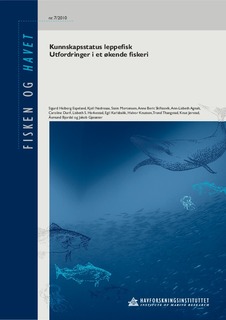| dc.contributor.author | Espeland, Sigurd Heiberg | |
| dc.contributor.author | Nedreaas, Kjell Harald | |
| dc.contributor.author | Mortensen, Stein H. | |
| dc.contributor.author | Skiftesvik, Anne Berit | |
| dc.contributor.author | Agnalt, Ann-Lisbeth | |
| dc.contributor.author | Durif, Caroline M.F. | |
| dc.contributor.author | Harkestad, Lisbeth S. | |
| dc.contributor.author | Karlsbakk, Egil | |
| dc.contributor.author | Knutsen, Halvor | |
| dc.contributor.author | Thangstad, Trond | |
| dc.contributor.author | Jørstad, Knut Eirik | |
| dc.contributor.author | Bjordal, Åsmund | |
| dc.contributor.author | Gjøsæter, Jakob | |
| dc.date.accessioned | 2011-03-04T09:48:44Z | |
| dc.date.available | 2011-03-04T09:48:44Z | |
| dc.date.issued | 2010-11-15 | |
| dc.identifier.issn | 0071-5638 | |
| dc.identifier.uri | http://hdl.handle.net/11250/113891 | |
| dc.description.abstract | Over the past few years there has been a rapid increase in the use of wrasses as cleanerfish for sealice on salmon farms. During 2010, the landed catch of wrasse was 440 tons, more than twice the 2009 catch and nearly ten times the 2008 catch. This rapid and exrteme increase in the fishing pressure on these species has occurred despite very limited knowledge of their biology, ecology and population dynamics. This has led to justifiable concern about the sustainibility of this resource. Wrasse demonstrate specialized life history traits. Many species change sex during their lifetime and exhibit species-specific mating behaviour, including nest building and parental care of eggs. This mating strategy lends to limited dispersal of offspring, ond only goldsinny wrasse have pelagic eggs. Many adult individuals are stationary, thereby creating a population struction dominated by Iocal populations. This population structure is also documented through genetic sludies in corkwing and goldsinny wrasse. Small local populations are more vulnerable to overfishing and possible extinction of local genetic adaptations. Studies of growth of wild wrasse demonstrate that goldsinsy and rock cook grow slower than corkwing. This suggests that the first two will take longer to recover from heavy fishing pressure. Results presented here suggest that both the composition of species and the size distribution; vary between habitats, particularly between exposed and sheltered areas. More precise and complete information on population structure. growth and maturation of these species is required 10 provide the knowledge base for sustainable fishing. Better knowledge of the health and welfare of these species - in salmon co-culture scenarios - is also needed. | en_US |
| dc.language.iso | nob | en_US |
| dc.publisher | Havforskningsinstituttet | en_US |
| dc.relation.ispartofseries | Fisken og havet;7-2010 | |
| dc.subject | wrasse | en_US |
| dc.subject | leppefisker | en_US |
| dc.subject | fisheries | en_US |
| dc.subject | fiskerier | en_US |
| dc.subject | population structure | en_US |
| dc.subject | populasjonsstruktur | en_US |
| dc.title | Kunnskapsstatus leppefisk : Utfordringer i et økende fiskeri | en_US |
| dc.title.alternative | Current knowledge on wrasse - challenges in an increasing fishery | en_US |
| dc.type | Research report | en_US |
| dc.subject.nsi | VDP::Agriculture and fishery disciplines: 900::Fisheries science: 920::Resource biology: 921 | en_US |
| dc.source.pagenumber | 38 s. | en_US |
